the john muir exhibit - john_muir_national_historic_site - gravesite
John Muir's Gravesite
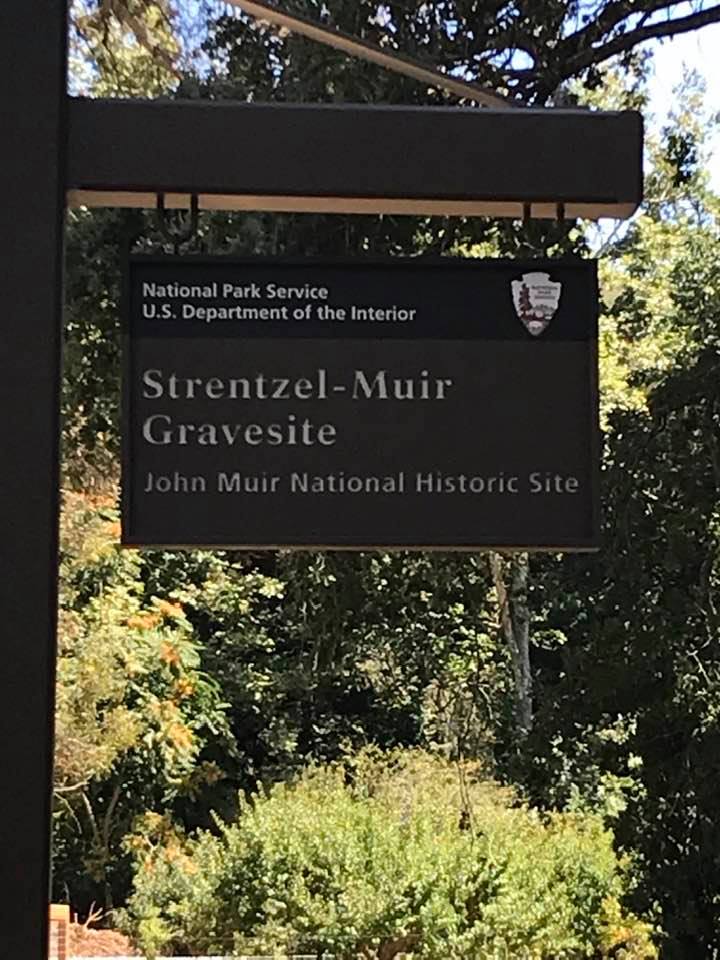 "All the merry dwellers of the trees and streams, and the myriad swarms of the air, called into life by the sunbeam of a summer morning, go home through death, wings folded perhaps in the last red rays of sunset of the day they were first tried. Trees towering in the sky, braving storms of centuries, flowers turning faces to the light for a single day or hour, having enjoyed their share of life's feast- all alike pass on and away under the law of death and love. Yet all are our brothers and they enjoy life as we do, share heaven's blessings with us, die and are buried in hallowed ground, come with us out of eternity and return into eternity.... Let children walk with Nature, let them see the beautiful blendings and communions of death and life, their joyous inseparable unity, as taught in woods and meadows, plains and mountains and streams of our blessed star, and they will learn that death is stingless indeed, and as beautiful as life, and that the grave has no victory, for it never fights. All is divine harmony."
"All the merry dwellers of the trees and streams, and the myriad swarms of the air, called into life by the sunbeam of a summer morning, go home through death, wings folded perhaps in the last red rays of sunset of the day they were first tried. Trees towering in the sky, braving storms of centuries, flowers turning faces to the light for a single day or hour, having enjoyed their share of life's feast- all alike pass on and away under the law of death and love. Yet all are our brothers and they enjoy life as we do, share heaven's blessings with us, die and are buried in hallowed ground, come with us out of eternity and return into eternity.... Let children walk with Nature, let them see the beautiful blendings and communions of death and life, their joyous inseparable unity, as taught in woods and meadows, plains and mountains and streams of our blessed star, and they will learn that death is stingless indeed, and as beautiful as life, and that the grave has no victory, for it never fights. All is divine harmony."
- John Muir
John Muir's burial site is in a quiet, tree-shaded spot near the banks of Alhambra Creek, about one mile south of the Muir homestead and the National Historic Site visitor center. For many years privately owned by the Muir-Strentzel family, this 1.27 acre site is now part of the John Muir National Historic Site, managed by the U.S. National Park Service.
The Death of John Muir
John Muir, the champion of wilderness, died on Christmas Eve 1914 in California Hospital, Los Angeles. Challenged by the heart-breaking loss of the Hetch Hetchy battle, and by what he called "the grippe" (influenza), in November 1914 he was thinking of going south as a respite from the rainy season of the Bay Area. But due to ill health, he declined an invitation from the Angeles Chapter to join their annual Christmas Holiday outing in southern California at the Muir Lodge, which had been dedicated just a year earlier. But then he decided to visit his daughter Helen and her family in Daggett (near Barstow), to rekindle family ties and breathe the desert air. During the visit, his cold or flu developed into pneumonia. His daughter asked her husband Buell to take him to the California Hospital in Los Angeles. Early on the day before Christmas, alone in his hospital room, John Muir died. His unfinished Alaska manuscript lay scattered on his blankets. His body was shipped home to Alhambra Valley, where he was to be buried next to his beloved wife Louie. On December 26, the Sierra Club held a memorial service at Muir Lodge for their beloved leader, and over the next several days newspapers all around the nation carried his obituary and published tributes to him.
John Muir's Funeral
John Muir was buried here beside his wife, Louie Strentzel Muir, on Sunday, December 27, 1914
(as reported in San Francisco Chronicle). Attended by numerous family members, friends, and neighbors, the funeral was also attended by over 100 members of the Sierra Club who traveled to Muir's burial from San Francisco and bay cities in a special train. At the Muir House, the simple casket rested in a bay window just below the study where he wrote most of his books. It was covered with a drapery of ferns and violets ... Some mourners brought branches of fir or pine to place beside the coffin. Among the floral tributes were a large laurel wreath with purple and gold ribbon, from the American Academy of Arts and Letters and a wreath of red roses, from the National Institute of Arts and Letters.. Muir's close friend and Sierra Club colleague William Frederic Badè, a professor of Semitic literature at the Pacific Theological Seminary, officiated, and gave an eulogy which quoted extensively from Muir himself (later published as "To Higher Sierras" in the Sierra Club Bulletin, John Muir Memorial Number, Vol. 10, No. 1 (January, 1916) and as the introduction to the Manuscript Edition of John Muir's Complete Writings). The funeral included reading the 23rd Psalm, and a quartet singing of the hymn "Lead, Kindly Light." Dr. Badè gave a prayer, expressing gratitude for the "rich treasures of beauty which he [Muir] taught men to see; that he ever noted a deeper meaning in the azure of its skies, in the brightness of its sunshine, in the flowery sheen of its valleys and the rugged white splendor of the high Sierra. Grant us a heart wide open and ever open to all this joy and beauty because he tarried among us." When Muir was a lad in Scotland, the school day would close with the song, "Lord, Dismiss Us With Thy Blessing;" and so, this was sung by the mourners to close the service.
Moving to the gravesite a mile away, a brief ceremony was held at which Dr. Badè read from scripture and the mourners sang the hymn "Rock of Ages." The pallbearers were W.E. Colby and Congressman-elect J. Arthur Elston, representing the Sierra Club; Frank V. Cornish, who represented the Wisconsin Society, and Elam Brown, Frank Swett and George Griffin, neighbors. As the coffin was lowered into the ground, "a member of the Sierra Club placed on the coffin a bough of the Sequoia gigantea which the naturalist had planted with his own hand near what is now his grave." The San Francisco Chronicle, in uncharacteristic poetic fashion, reported that "As the beloved body was being lowered into the grave, quail on the side hills called out their farewells and overhead, in trees Muir himself planted forty years ago, God's feathered creatures, that had come to know, and not to fear the man, sang his requiem."
John Muir Burial Site
Dr. John Strentzel (John Muir's father-in-law) and his wife Louisiana Strentzel chose this site as their final resting place. Dr. Strentzel planted the pear orchard, as well as the large manna gum eucalyptus, the California bay laurel, and the incense cedar which still thrive in the southwest corner of the cemetery area.
There once was a yew tree (now a stump), said to have been planted by John Muir, located near John Muir's grave, which is mentioned in the poem The Burial of John Muir by Charlotte Kellogg published in the Sierra Club Bulletin after the funeral. The yew tree was often planted, especially in Britain, since ancient times, in churchyards and cemeteries, and is commonly regarded as a symbol of immortality or everlasting life. Muir would have resonated with it being a symbol for the regenerative power of nature. For many years, the ground cover in the enclosed part of the cemetery used to be covered with low-lying green creeping myrtle (aka "Periwinkle"), readily seen in older photographs. Family lore says that Mrs. Strentzel planted the myrtle, though the National Park Service considers it a non-significant and invasive non-native plant.
The actual enclosure for the cemetery is located at the back of the property next to the creek, nestled by trees.
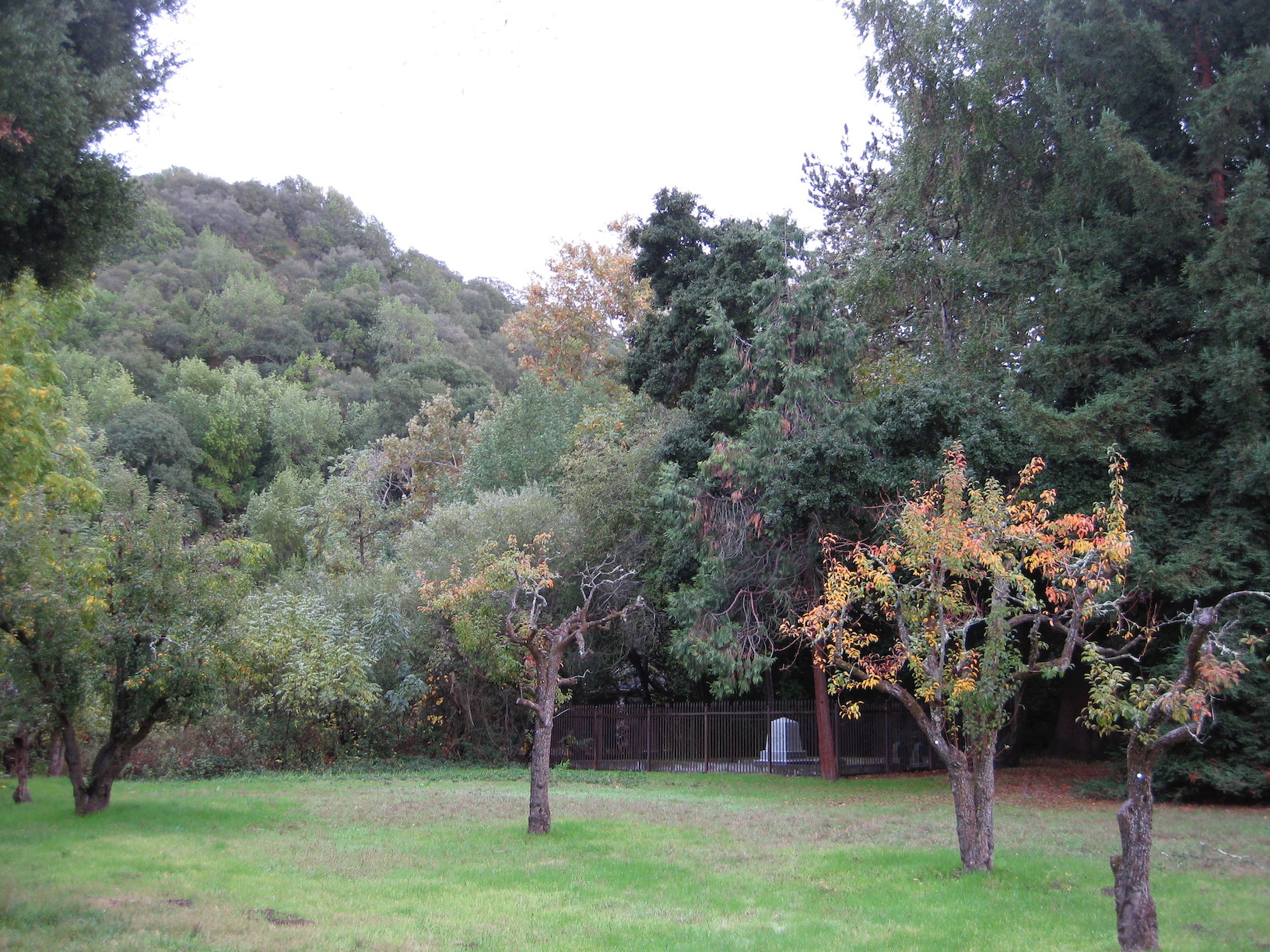
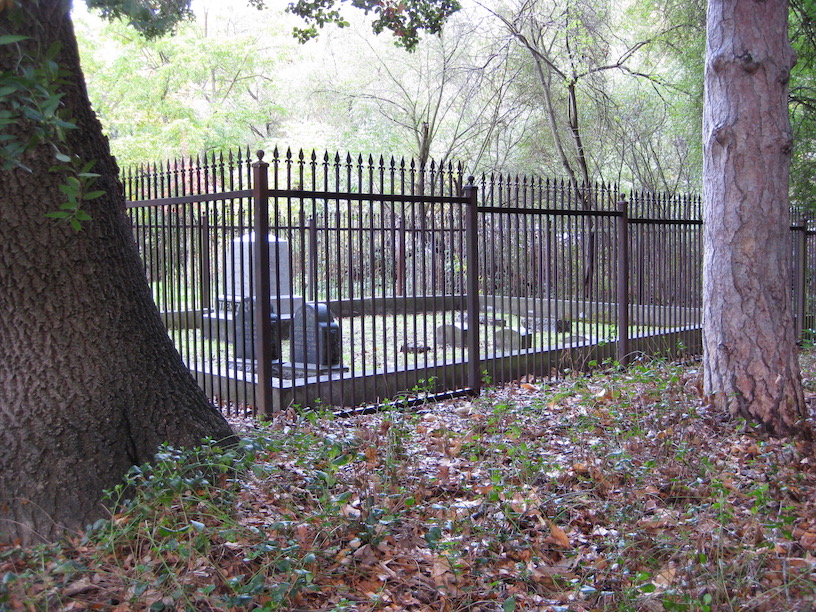
Headstones and Markers
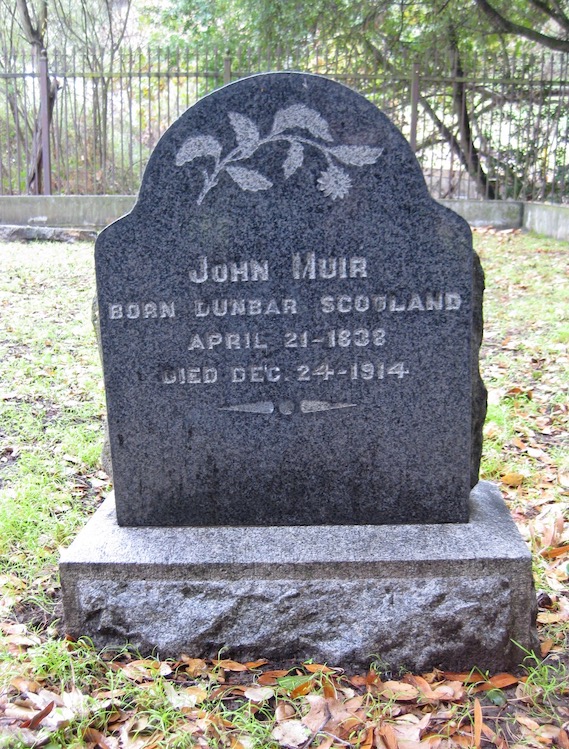
John and Louie Muir's headstones are made of Black Academy Granite with Raymond Granite bases. Both display an ornate floral design believed to be the thistle, the national emblem of John Muir's Scottish homeland.
The cemetery plot is defined by a curb (cope) of Raymond Granite (now called "Sierra White") from the Raymond quarry near Knowles, California, The Strentzel monument and family
headstones are also cut from the same granite.
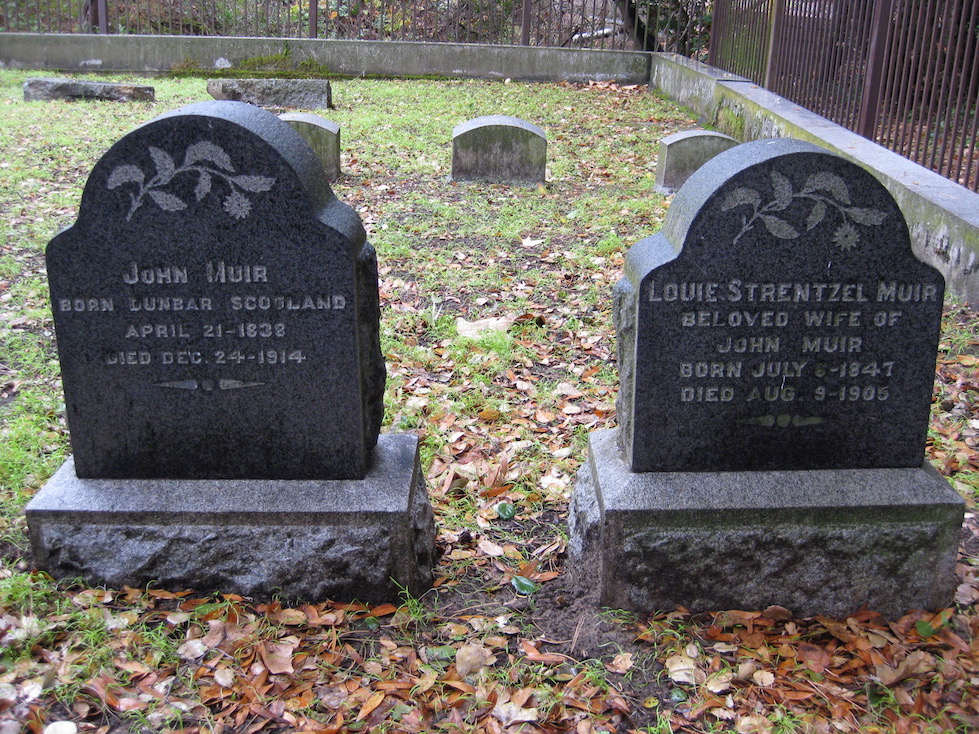
A Family Cemetery
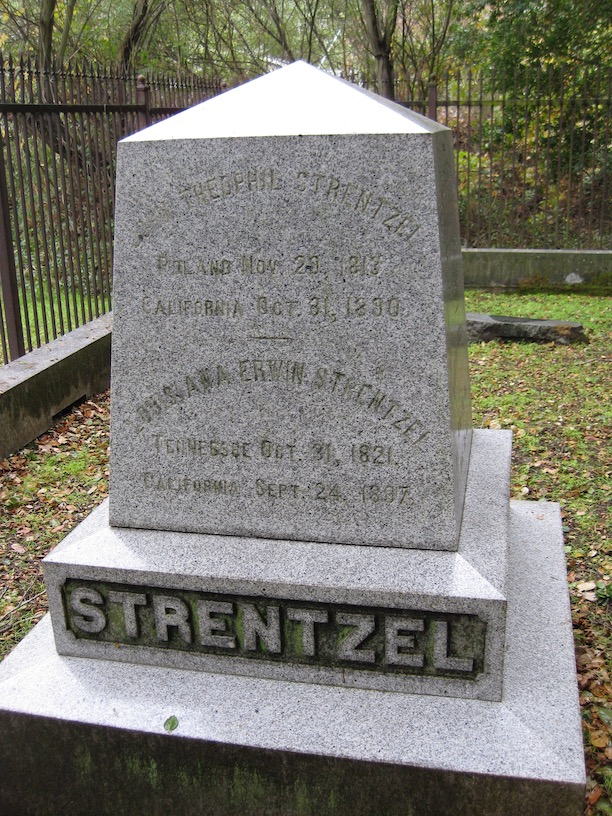 The largest monument in this family cemetery is a mutual monument for Muir's father-in-law and mother-in-law, Dr. John Strentzel and his wife Louisiana. John Strentzel died October 31, 1890, while Louisiana died September 24, 1887. The obelisk also has inscribed the name and their son who died in infancy, John Erwin.
The largest monument in this family cemetery is a mutual monument for Muir's father-in-law and mother-in-law, Dr. John Strentzel and his wife Louisiana. John Strentzel died October 31, 1890, while Louisiana died September 24, 1887. The obelisk also has inscribed the name and their son who died in infancy, John Erwin.
Several additional small markers in the enclosure honor other deceased family members. Louie Strentzel Muir, (July 6, 1847 - August 6, 1905) John Muir's wife, had two siblings, both of whom passed on at an early age. Her sister Lottie died after only four months of life. This loss occurred in 1851, long before the Strentzel's came to the Alhambra Valley.
It is not known if Lottie's body was moved to be buried at this site. Louie's other sibling, John Erwin Strentzel, died at the age of nine in 1857. Louie's uncle, Henry Christian Strentzel, was buried at the gravesite in 1865.
The last two people buried at the gravesite were Muir's oldest daughter Wanda Muir Hanna (in 1942) and her husband, Thomas Rae Hanna (in 1947). The flat-bottomed granite headstones for Tom and Wanda came from an old arrastra (a mill for grinding and pulverizing gold or silver ore) at Lundy, eastern Sierra, where the Hanna family had a small cabin.

Other Graves and Cemeteries
Other members of John Muir's family are buried elsewhere. His father Daniel Muir is buried at Elmwood Cemetery in Kansas City, Missouri. His mother, Ann Gilrye Muir, is buried at Silver Lake Cemetery, Portage, Wisconsin (off-site link).
Muir's younger daughter Helen Lillian Funk Muir is buried next to her husband, Buel Alvin Funk at Bellevue Memorial Park, Ontario, San Bernardino County, California. His brother David Muir, and his sisters Sarah Muir Galloway, and Margaret Muir Reid and her husband John are buried at the Alhambra Pioneer Cemetery nearby in Martinez (off-site link). Other of John's siblings are buried at various locations around the country, including Michigan, Oregon, and Wisconsin. John Muir and Louie had 10 grand-children, all of whom are now deceased and buried at several different locations.
Pilgrimages to the Gravesite
Since Muir's death in 1914, many people have made pilgrimages to the gravesite to honor Muir and his contribution to the conservation movement.
Pilgrims over the years included such people as Muir's friends John Burroughs, William Colby, long-time Sierra Club leader; Charles Keeler, poet and friend of John Muir; and admirers and authors, including Linnie Marsh Wolfe, author of the Pulitzer Prize-winning biography of John Muir, and David Brower, long-time Executive Director of the Sierra Club. Sierra Club sponsored annual pilgrimages from 1959 through 1974. Of course Muir family members have been frequent visitors over the years. Muir descendant Susan Flynn recalls, "I grew up about an acre away from the gravesite. My brothers, cousins, also Muir descendants, and I used to play there, climb the trees, and make rubbings off the tombstones. There used to be a pilgrimage on the anniversary of Muir's death with speakers, bagpipers, and quite a few people in attendance. I have pictures when I was a toddler with my grandmother, Wanda, under the big Eucalyptus tree. My mother, Sherry Hanna, took care of the gravesite after Joe (Jose) Figuerado died and often took people to see it."
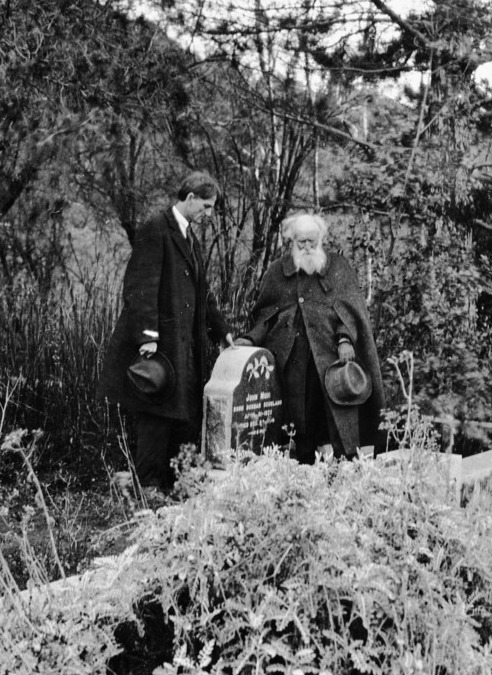
In this undated historic photo, Muir's close friends John Burroughs, right, and Charles Keeler are seen paying their respects at Muir's gravesite. Photo is from the Yosemite Historic Photo Collection, US National Park Service, Yosemite National Park Archives.
Historically large gatherings including members of the Muir family, the Sierra Club, the federated women's clubs of Alameda County, local historians, and the John Muir Memorial Association, came to the gravesite to commemorate Muir. For some time, these pilgrimages were annual. Typically held in the spring on or near John Muir's birthday, in one such ceremony, each pilgrim stepped forward to lay a rose upon John's grave. It was reported that another tradition was to sing "Auld Lang Syne" with arms linked encircling the giant eucalyptus tree at the site.
Beginning in 1930, these annual pilgrimages seem to have become more organized, with speakers and guests to address his accomplishments and celebrate his life. Mrs. H.J. Taylor wrote this description of these pilgrimages in 1936: "Annually in April, the month of Muir's birth, the federated women's clubs of Alameda County, members of the Sierra Club, and others interested meet at the Strentzel Ranch. Under the great white-boled Eucalyptus tree standing near the entrance to the family burial lot a program is presented. Wreaths are placed upon the graves by Boy Scouts and Camp Fire Girls. Those who have walked and talked with Muir rehearse these precious hours. The presence of Muir's oldest daughter, Mrs. Wanda Muir Hanna, adds much interest to the occasion. It is mainly through the efforts of Mrs. Linnie M. Wolfe that the pilgrimage is increasingly interesting and attractive in its program. In April, 1936 about three hundred pilgrims gathered at the Hanna Ranch near Martinez. Scotch Bag Pipers, in colorful plaids and kilts, played Scotch music and a descendant of Annie Laurie sang that favorite song. At the close of the program all join hands about the tree as they sing "Auld Lange Syne." From the distant hills are heard the buglers' taps. Slowly the Pilgrims depart." (from John Muir, a chapter in Yosemite Indians and Other Sketches (1936) by Mrs. H. J. Taylor.). A newspaper report from 1936 reported that the committee in charge of that 1936 pilgrimage included Mrs. James Kinney, of Antioch, district chairman of History and Landmarks; Mrs. Thomas Hanna (Wanda Muir), daughter of John Muir; Mrs. Harry Leonard, president of Contra Costa County Federation of Hebrew Congregations, and others. The event included The Bagpipers of Piedmont High School.
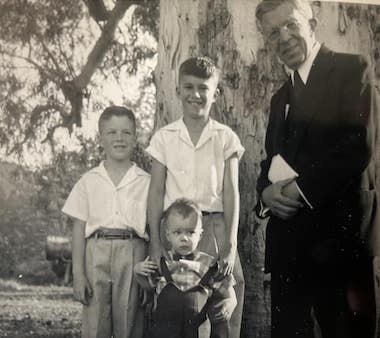 At a 1957 visit to the gravesite, Muir's friend and close family friend even after his death, Brother Cornelius, was photographed with Muir's great-grandsons Dennis, Tim, and Neil Hanna.
At a 1957 visit to the gravesite, Muir's friend and close family friend even after his death, Brother Cornelius, was photographed with Muir's great-grandsons Dennis, Tim, and Neil Hanna.
At the April 21, 1957 gathering, all of Muir's grandchildren and all 17 of his great grandchildren were in attendance.
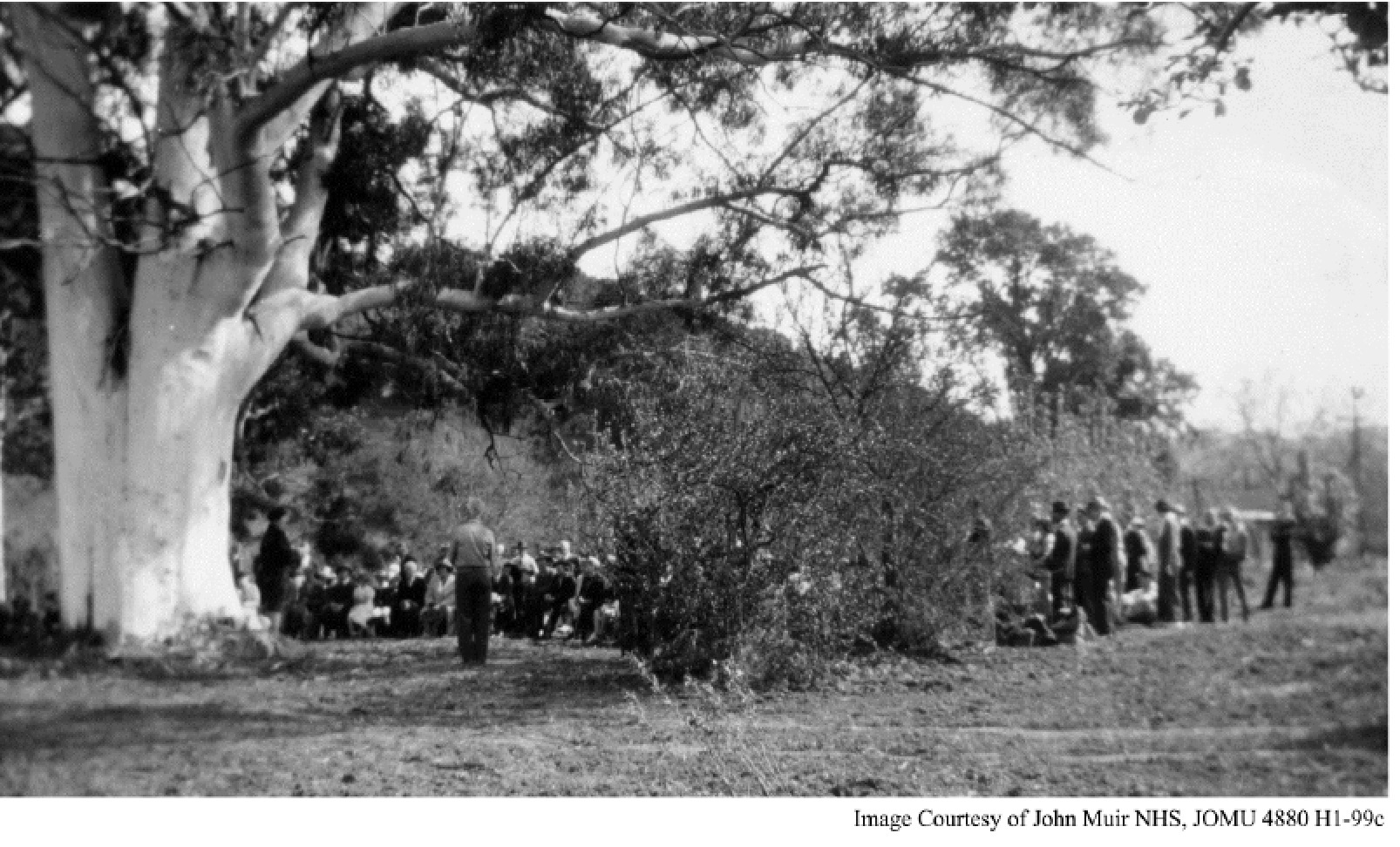
Modern pilgrims have included Lee Stetson (right), who performs as John Muir in Yosemite, and Harold Wood, webmaster of this website, the John Muir Exhibit.
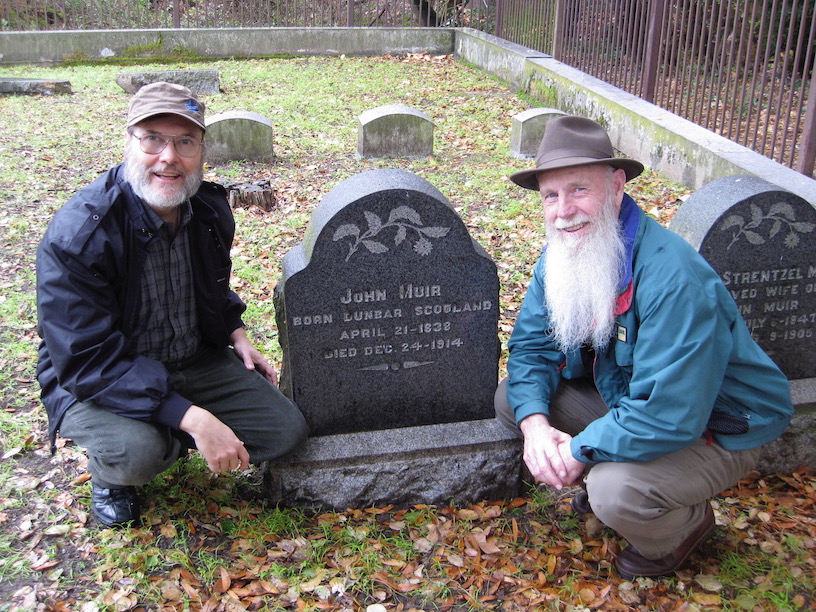
Professor Bill Swagerty (right) from the University of the Pacific's John Muir Center, brought his students in 2004 for a visit, where they met John Muir's grandson, the late Ross Hanna, as shown here:
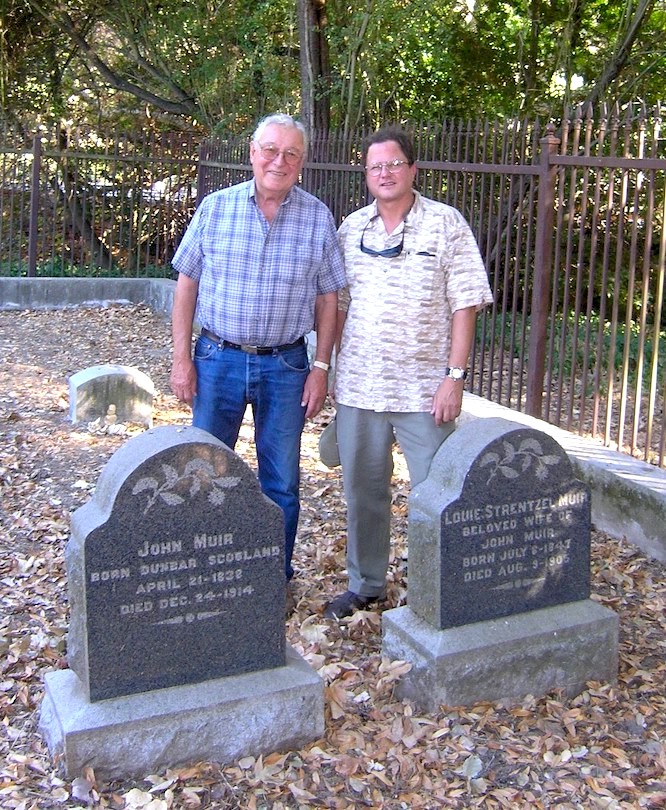 (Photo courtesy of Bill Swagerty)
(Photo courtesy of Bill Swagerty)
Today, Muir's descendants remain frequent visitors to the cemetery. John Muir's great-great-grandson Robert Hanna is one of the family members who are allowed to enter the fenced area of the gravesite.

Management and Providing for Visitation
Through the efforts of a private land conservation group, the Strentzel-Muir gravesite parcel was added to the John Muir National Historic Site in 2000. Because the small parcel is surrounded by single-family residences to the north, west and south, and bounded by the creek to the southeast, visitation to the gravesite has been problematic for many years. Indeed, providing visitor use in a manner that respects surrounding landowners who live in close proximity to the gravesite, as well as the desires of the Muir family and the general public, has been a challenge which has taken years to address.
The original John Muir National Historic Site was established in 1964 and was comprised of the Muir House, the Martinez Adobe, and their surrounding grounds. In 1980, the National Park Service conducted a study to assess the feasibility of adding the gravesite to John Muir National Historic Site, finding that the addition would in fact be feasible. At that time the 1.27 -acre parcel was owned by the Muir-Hanna Family Trust. In 1988, Congress passed legislation to add the Strentzel-Muir gravesite parcel to John Muir National Historic Site. Though the parcel remained in private ownership, in 1991 the National Park Service completed a General Management Plan for the entire National Historic Site that included a conceptual strategy for managing the gravesite parcel for when it will come into NPS ownership. In 1993, the American Land Conservancy purchased the property from the Muir-Hanna Family Trust with the intent of transferring it to the National Park Service when funds became available. The National Park Service purchased the gravesite property from the American Land Conservancy in 2000.
Between 2000 and 2017, planning was delayed as the NPS, neighbors, and the public all struggled with what the NPS termed "uncertainty regarding appropriate levels of visitor use and appropriate resource management strategies." During that time, the site was officially not considered "open" to the public; however "those in the know" could walk to the site, and the NPS provided occasional van shuttle to the site upon special request. Those who tried to drive to the site quickly found that there were not only no parking spaces available, but barely room to even turn a car around. The gravesite is difficult to find even when visitors have a map directing them to the site, because the gravesite is tucked away at the end of an obscure private access-driveway, surrounded by shrubbery and fairly large single-family home parcels. It has no directional sign age leading to it, and the NPS for years would not disclose the location to visitors. Neighbors have remarked that visitors attempt to drive and park along nearby lanes and driveways in search of the gravesite, sometimes asking residents for directions, and often trespassing on their private land. These problems have been a long source of conflict between people who would like to visit the site, and the residents adjacent to the property.
As David Brower said in a February 2, 2000 newspaper account, "He [Muir] was one of the greatest we had. His accomplishments were terrific. The grave site should be more available to the public, and there should be something there to remind people about what he had done." Brower also said the land around the grave site "should have been preserved better. We have an addiction to growth," he said, "that we still haven't recovered from." But subdivision development around the cemetery plot began about 1940, long before historic site considerations came to mind.
As of December 2017, finally a visitation plan is in place that finally brings a way for members of the public to visit the site without disrupting the nearby neighbors.
John Muir NHS staff initiated planning for the Strentzel-Muir Gravesite Plan in spring 2013, and developed a range of 4 alternatives following a public alternatives development workshop in 2014.
In 2015, an Environmental Assessment was submitted for public review and then an amended Environmental Assessment came out in June of 2016, with a "preferred alternative" identified as "Alternative 4" in the plan.. A Finding of No Significant Impact was adopted in late September, 2017.
The final adopted alternative provides that pedestrians and bicyclists can access the site only during weekday hours, and no private vehicles will be allowed at any time, but NPS will provide daily shuttles from the Muir House to the gravesite both weekdays and weekends. The plan states: "The Selected Alternative will encourage a sense of reverence for Muir's life and legacy as the primary desired visitor experience at the gravesite, which will be ensured through the preservation of the historic landscape and through limiting group sizes and duration of stay. The NPS will actively manage visitor use at the gravesite by providing information via the park website, at the visitor center, and by providing a set number of ranger-led shuttles to the site described in detail below. Rules regarding how to access the site, when the site is open, and details regarding the gravesite's constraints within a quiet single-family residential neighborhood will be readily available. In the Selected Alternative, the entire 1.27-acre parcel will be fenced, greatly minimizing the ability for people to access the site when closed. Pedestrians and cyclists will have access through a pedestrian gate Monday through Friday from 10:30am-4:30pm , but through regulatory and interpretive signage, they too will be encouraged to respect the solemn, reverential character of the site. The Muir family will continue to have open access, and will also have the right to hold an annual, private, family commemoration at the gravesite - closed to the general public. Individuals, groups, universities, and non-profit organizations could request special use permits for tours and activities at the gravesite. These special requests will be managed on a case by case basis, as they currently are for the rest of John Muir National Historic Site, and will be accepted if determined appropriate to the site and protective of the resources and site character."
This plan will take some time to fully implement. In a press release, the NPS stated "Permanent site improvements, including fencing, paths and a parking area for the shuttle will be completed as funding becomes available. In the meantime, temporary facilities such as wheelchair accessible mats and perimeter fencing will be installed to accommodate visitation in the interim. Until permanent facilities can be completed, pedestrian and bicycle access will not be permitted." The van shuttle service from the National Historic Site visitor center began in December, 2017, and is now operating on a regularly scheduled basis. During public visitation periods, flowers or other mementos may not be placed on the graves.
As of spring of 2021, the new fencing, identification sign, an interpretive panel, a bench and walkway construction has been completed.
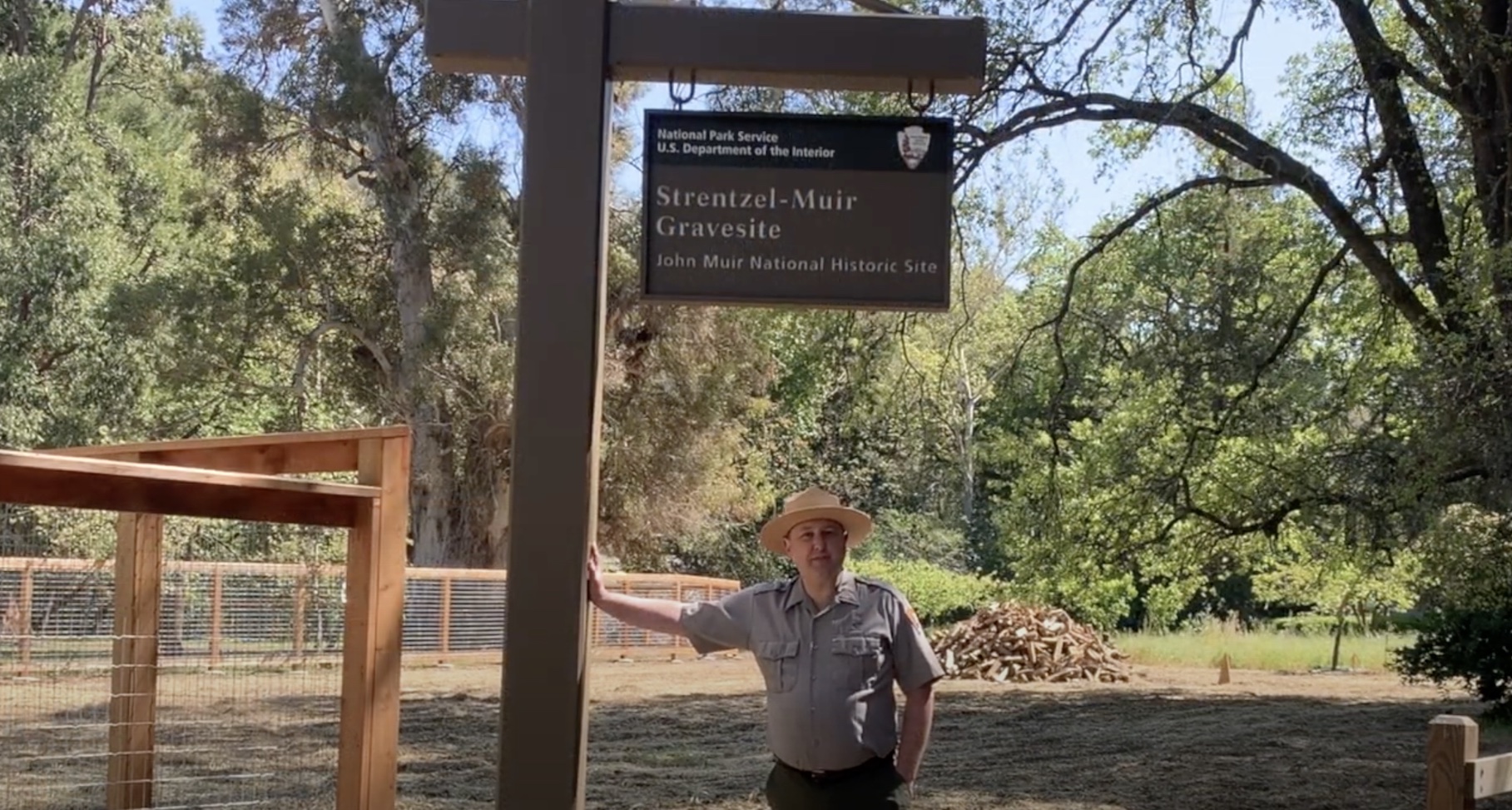
(Photo: John Muir National Historic Site Superintendent Tom Leatherman shows new signage and fencing at the gravesite, 2021.)
In April, 2021, the NPS announced that the gravesite is open to the public and is self-guided Monday through Friday from 10:30am to 4:30 pm. This will mark the first time in the park's history that regular access is available to the gravesite without being on a ranger led tour. However, ranger led tours of the site with a van shuttle are available on Saturday and Sunday when staff is available. Reservations are required due to limited seating for transportation. Call (925) 683-6943 for reservations.
(Video: National Park Service Virtual Presentation of recent renovations)
For more information:
Credits: New interpretive sign 2021 by Allison Flynn. Interpretive panel and photo of Tom Leatherman with fencing courtesy National Park Service. Other Photos except as noted by Harold Wood, taken in November, 2009.
Return to John Muir National Historic Site (JME) Home Page
Visit official John Muir National Historic Site (NPS) Home Page
Home
| Alphabetical Index
| What's New & About this Site